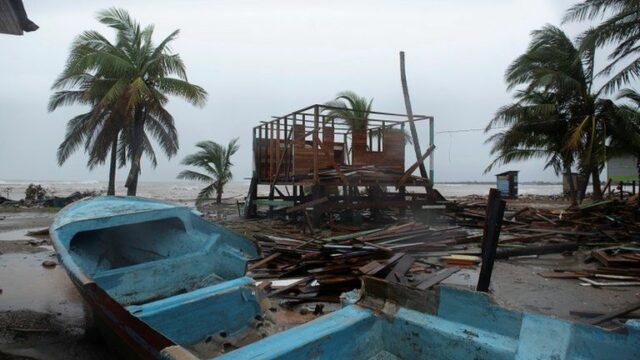
Hurricane Iota advanced this Tuesday with heavy rains and strong winds towards the interior of Central America, an area devastated two weeks ago by Hurricane Eta, after having lost some strength when it made landfall on Monday in the northern Caribbean of Nicaragua.
Stronger than its predecessor, Iota made landfall as a Category 5 hurricane with maximum winds of 260 km/hr, the National Hurricane Center (NHC) said in a report, but when it made landfall it began to lose strength.
“Hurricane Iota is rapidly weakening over northwestern Nicaragua,” the NHC stated in its latter note, nonetheless warning that it is expected to bring “catastrophic winds, life-threatening storm surge, and torrential rain”.
Iota follows the same path as Hurricane Eta, which left more than 200 dead and missing in Central America. Some 2.5 million people were affected by the Eta crossing, according to official estimates. Thousands of residents were transferred to shelters, while others remained in their fragile wooden houses. Inhabitants of the area assured that the wind tore off the roofs of the houses “as if they were made of cardboard.”
Thousands evacuated
Thousands of people were taken to shelters in Central America, while the leaders of the region agreed to form a common front to request international resources to help them deal with the damage caused by the two hurricanes.
Honduras, Nicaragua, and Guatemala have been carrying out evacuations since last week, and the hurricane also affects Panama and the Colombian island of Providencia. At least one person died in Providencia where it destroyed about 98% of its infrastructure, Colombian President Iván Duque reported.
A devastating hurricane season
The hurricane season in the Atlantic has broken records. Iota is the 13th of 30 named storms on record this year to reach hurricane status, forcing the use of the Greek alphabet.
The rains caused by Iota also hit the Honduran Caribbean, and downpours are expected on Tuesday in Tegucigalpa, where poor neighborhoods in the hills of the capital are at risk.
The Honduran Air Force anticipated heavy rains in the capital and northern San Pedro Sula, the industrial capital of the country heavily hit by Eta. Both Honduras and Nicaragua suffered the worst impacts of the last hurricanes in isolated and poor areas.
Northeast Nicaragua, an extensive and sparsely populated region, with inhabitants of the Miskito, Sumos, Garífuna ethnic groups, as well as Creole and mestizos, suffered the impact of Iota without having finished assimilating the effects of Hurricane Eta.
In Honduras, Iota caused gusts of winds and heavy rains in the eastern departments of Gracias a Dios – a Miskito population – Colón, northern Olancho and part of Atlántida, according to the state Permanent Contingency Commission (Copeco).
According to local media, more than 175,000 people had been evacuated since Saturday, especially in areas flooded during the Eta scourge in the Sula Valley, near San Pedro Sula.
Guatemala maintains surveillance in the provinces of Alta Verapaz, Izabal, Quiché, Huehuetenango, Petén, Zacapa and Chiquimula, in the northern, western and eastern regions, hard hit by Eta and still with dozens of communities isolated by landslides and floods, according to Yelson Samayoa, director of the Institute of Meteorology. El Salvador and Panama also declared a red alert in anticipation of the effects of Iota.
Faced with the double attack of hurricanes, the presidents of Guatemala, Honduras, Nicaragua, and Costa Rica cried out this past Monday for help from the international community to rebuild their countries, during a virtual meeting.
The president of the Central American Bank for Economic Integration (CABEI), Dante Mossi, present at the meeting, proposed to refocus $ 2.5 billion of the entity “to restore infrastructure, dams, and construction of social housing.”

